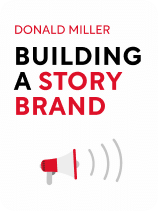

This article is an excerpt from the Shortform book guide to "Building a Storybrand" by Donald Miller. Shortform has the world's best summaries and analyses of books you should be reading.
Like this article? Sign up for a free trial here .
What is the Donald Miller Building a Storybrand book about? What is a storybrand and why do you need one?
Donald Miller’s Building a Storybrand is about approaching your brand the same way you tell a story. You storybrand and your accompanying brandscript should have all the major elements of a story, including a hero, a plot, and more.
Keep reading to find out more about Donald Miller’s Building a Storybrand.
Donald Miller: Building a Storybrand
In Donald Miller’s Building a StoryBrand, marketing expert Donald Miller explains how to create effective marketing messages and materials. He covers:
- What doesn’t work—marketing that’s confusing, overwhelming, narcissistic, or that takes too much energy to understand.
- What does work—framing your message as a story using a method called the storybrand 7-Part Framework (SB7).
- How to implement your SB7 story into a variety of marketing materials.
- How to leverage the power of story to create company culture and increase employee engagement.
Why Most Marketing Doesn’t Work
The only thing customers care about is how your brand can solve their problems. As a result, marketing that’s unclear or confusing, doesn’t explain how your product solves problems, or that is self-centered and obsesses about the company’s image, is doomed to fail.
For example, a beautiful website with pictures of your office building that doesn’t explain that you sell life-saving medicine isn’t going to win you any business. Even if your competitor’s medicines aren’t as good as yours, if their communication is better, they’ll win the customers.
Donald Miller: Building a Storybrand Makes Marketing Work
The author, who founded a company called StoryBrand, has streamlined storytelling into a process called the storybrand 7-Part Framework (SB7). Using this framework, you’ll follow a step-by-step process to create a brandscript, which is a document similar to the grids or storyboards that storytellers use to create movies or books. Once you’ve created your brandscript, you’ll be able to draw on its ideas to write copy and create content you can use in your marketing materials.
According to Donald Miller in Building a Storybrand, there are seven elements to the SB7 formula: The hero (customer) wants something (1) and encounters a problem (2) that stops her from getting it. She needs the help of a guide (your brand) (3) who has a plan (4) to help her solve the problem. The guide (brand) must call on her to act (5). The stakes must be clear—what does she stand to lose if she doesn’t act (6) and what she might gain if she does act (7)?
Here’s an example of how the formula looks for a brand: (Shortform example: A college student wants study snacks (1) but doesn’t have any free time in which to cook (2). SnackCrate (3) is a company that mails crates of snacks to subscribers once a month (4). The “Subscribe” button on the SnackCrate website calls the student to sign up (5). If the student doesn’t order the snacks, she’ll be hungry (6). If she does, she’ll feel full and she’ll have more free brainpower to put towards studying (7).)
This seven-part story arc is common and popular because it captures the human condition so well. Everyone doubts themselves and wants to save the day and be a hero.
Implement Your Brandscript
Now that you have a brandscript, it’s time to transfer the ideas and content in that script to your marketing materials. According to Donald Miller Building a Storybrand the more you can implement your brandscript into your marketing materials, the more customers will sign up to star in your story.
There are six ways to implement your brandscript:
1. Overhaul your website. Most likely, your website has too much noise and distracting information on it. The only two pieces of information you actually need on it are: 1) your brand offers something a customer wants and 2) you can help the customer get what they want. Every single image, idea, and word on your website should be inspired by your brandscript. To overhaul your site:
- Place a short phrase and image that explain what your brand does on the top part of your website.
- Make the call to action buttons unmistakable.
- Use images of happy-looking people using your products to demonstrate customer transformations.
- If you have more than one revenue stream (for example, you paint both cars and houses), come up with an overall message that represents what you do as a whole. (If you absolutely can’t, you can market your revenue streams separately.)
- Pare down content by replacing text with images, paragraphs with bullet points, and sentences with soundbites.
2. Write a brand logline. A brand logline is a short, often one-sentence description of a brand that summarizes its story and invites customers to star as the hero. The logline should include the customer, problem, plan, and positive stakes from the brandscript.
- (Shortform example: If you sell exam prep courses, your line might be: “We help students who are confronted with tough exams improve their study habits to achieve high grades.”)
3. Use a lead generator to create email lists. A lead generator is something that interests customers in your brand and encourages them to give you their email. Lead generators need to do at least one of the following: 1) give your customers something valuable, such as free information, or 2) demonstrate your authoritativeness in the industry.
- Some examples are downloadable guides, web series, free trials, free samples, or free events.
4. Build an automated email nurturing campaign. A nurturing campaign is a series of emails that offer valuable information related to your brand. The first three emails in the campaign share information and the fourth is a call to action. Then, the pattern repeats.
5. Collect testimonials about transformation. Testimonials are statements from previous customers that endorse your brand or product. The best testimonials show that: 1) your brand is valuable and 2) a customer had a positive experience working with you that culminated in results.
6. Build a referral system. A referral system encourages satisfied customers to recommend your brand to others. To create a referral system, create a transitional call to action that you can send to your customers to pass on to their friends, and optionally reward customers for referring friends by offering them a gift or percentage of the sale when their referral results in a purchase.
Create Company Culture and Increase Employee Engagement
In addition to using stories to clearly communicate with and engage your customers, you can use stories to communicate and engage with your employees. Workplaces that use stories have strong culture, and those that don’t have weak culture.
Donald Miller’s Building a Storybrand is a great way for companies to establish themselves and create a loyal customer base.

———End of Preview———
Like what you just read? Read the rest of the world's best book summary and analysis of Donald Miller's "Building a Storybrand" at Shortform .
Here's what you'll find in our full Building a Storybrand summary :
- How storytelling enhances brand marketing
- Why you should make the consumer the hero of your brand's story
- The 7 elements that make marketing work






